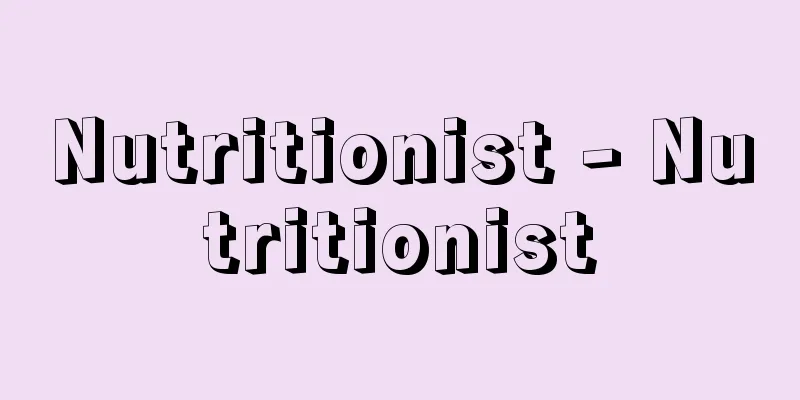Nutritionist - Nutritionist

|
It is one of the nationally recognized qualifications established by the Dietitian Law, and there are two types: dietitian and registered dietitian. The main job of a dietitian is to provide nutritional guidance to individuals or groups, and to work on improving eating habits and nutritional management, with the aim of maintaining and improving people's health. The history of dietitians in Japan began when 13 graduates of Saeki Nutrition School, which was founded in 1924 (Taisho 13), entered society as dietitians in 1926 (Taisho 15). At the time, it was not a national status and there was no guarantee of it, but it was institutionalized with the establishment of the "Dietitian Regulations" in 1945 (Showa 20), and the Dietitian Law was enacted in 1947. New qualifications were added to registered dietitians in 1987, and with the revision of the Dietitian Law in 2000 (Heisei 12), registered dietitians were made licensed in addition to dietitians, replacing the previous registration system. Regarding the distinction between the two, registered dietitians are said to carry out work that requires more advanced specialized knowledge and skills than dietitians, such as providing nutritional guidance to sick people and managing school meals. A license to become a dietitian is given by the prefectural governor to those who have graduated from a dietitian training facility (2 years or more). A license to become a registered dietitian is given by the Minister of Health, Labour and Welfare to those who have passed the national examination. Eligibility to take the national examination requires that one has graduated from a 4-year registered dietitian training facility, or that one is a dietitian with a total of 5 years or more of experience in addition to the required number of years at a training facility. The scope of activities of nutritionists is extremely broad, and they provide nutritional guidance in government organizations such as health centers and boards of education, medical institutions such as hospitals and clinics, welfare facilities, and various food service facilities, as well as working in nutrition and food-related research institutes, menu development for food companies, consumer affairs offices, and nutrition counseling at sports centers. As a future direction, the separation of duties between nutritionists and registered dietitians and the improvement of qualifications, such as qualifications in specialized fields such as school lunches, clinical practice, public health, and management, are being considered. In addition, a system that requires regular study even after obtaining a license is also being considered. [Yonago, Yamaguchi] "The History of the Development of the Dietitian System: 50 Years of the Dietitian Association" (1994), edited and published by the Japan Dietetic Association ; "Dietitians and Registered Dietitians" (1998, Tokyo Shoten), edited by Arai Mitsuo, Ochiai Satoshi, and Yamamoto Hiromi ; "Questioning Food Education and Dietitians: Thinking from the Perspective of School Lunches" (2006, Tsukuba Shobo), written by Kawai Tomoko, Sato Makoto, and Kubota Nozomi. Source: Shogakukan Encyclopedia Nipponica About Encyclopedia Nipponica Information | Legend |
|
栄養士法により身分の確立された国の認定する資格の一つで、栄養士と管理栄養士の2種類がある。そのおもな業務は栄養指導で、個人あるいは集団に対して食生活の改善や栄養管理などに取り組み、人々の健康の保持、増進を目的としている。 日本の栄養士の歴史は1924年(大正13)に創設された佐伯(さえき)栄養学校の卒業生の13名が、26年(大正15)に栄養士として社会に出たのに始まる。当時は国家的身分ではなく、その保障もなかったが、45年(昭和20)「栄養士規則」の制定により制度化され、47年に栄養士法が制定された。管理栄養士については62年に資格が新たに追加され、2000年(平成12)の栄養士法の改正によって、栄養士に加えて管理栄養士をそれまでの登録制から免許化した。両者の区分について、管理栄養士は疾病者の栄養指導、給食管理など栄養士よりも高度の専門知識や技術を必要とする業務を行うとしている。 栄養士の免許は栄養士の養成施設(2年以上)を卒業した者に都道府県知事が与える。管理栄養士の免許は国家試験に合格した者に厚生労働大臣が与える。国家試験の受験資格は、4年間の管理栄養士養成施設を卒業したもの、または栄養士であって養成施設の規定年数と実務年数が合計5年以上の者となっている。 栄養士の活動範囲は非常に広く、保健所・教育委員会などの行政関係、病院・診療所などの医療機関、福祉施設や各種給食施設における栄養指導のほか、栄養・食糧関係の研究機関、食品会社のメニュー開発・消費者窓口やスポーツセンターの栄養相談などの業務に携わっている。 今後の方向として、栄養士と管理栄養士の業務の分離や、給食、臨床、公衆、経営などの専門分野での資格化など資質の向上が検討されている。また、免許取得後も一定期間ごとに学習を義務づける制度なども検討されている。 [山口米子] 『日本栄養士会編・刊『栄養士制度発展のあゆみ――栄養士会50年のあゆみ』(1994)』▽『荒井光雄・落合敏・山本博美編『管理栄養士・栄養士』(1998・東京書店)』▽『河合知子・佐藤信・久保田のぞみ著『問われる食育と栄養士――学校給食から考える』(2006・筑波書房)』 出典 小学館 日本大百科全書(ニッポニカ)日本大百科全書(ニッポニカ)について 情報 | 凡例 |
Recommend
Shintoism
...However, when Shinto was made the state religi...
geysir
...a hot spring that erupts at regular intervals,...
Pleistocene - Pleistocene
〘noun〙 A division of geological time. It belongs t...
AWSA - AWSA
…Initially, they tried to realize women's suf...
Wabai (English spelling) hé mǎi
A Chinese financial term. It refers to the purchas...
Pyatachok
… [Monetary system] The metric system has been us...
Judgment (Kendan)
It means to investigate violations and denounce il...
siphon
…A device in which a long curved pipe is inverted...
Botany - Botany
A branch of biology that studies plants. Humans h...
Runddorf
…(4) Waldhufendorf: A type of village seen in lat...
Kigoke - Kigoke
This arborescent lichen grows on rocks along roads...
Anna Karenina
A full-length novel by Russian novelist Leo Tolsto...
Mingyu Chin - Meigyokuchin
One of the warlords at the end of the Yuan Dynast...
Agapornis taranta (English spelling) Agapornistaranta
…Parakeet [Takashi Saito]. . . *Some of the termi...
Essential Amino Acids - Hissu Aminosan
Food proteins contain approximately 20 types of a...









